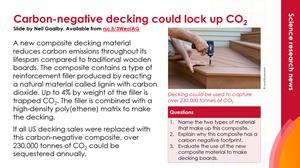Replacing decking materials sold annually in the US with the carbon-negative composite would be equivalent to taking more than 50,000 cars off the road
-

Download this
Use this story and the accompanying summary slide for a real-world context when studying composites and reducing carbon footprint with your 14–16 learners.
Download the story as MS Word or PDF and the summary slide as MS PowerPoint or PDF.
Researchers at the US Department of Energy’s Pacific Northwest National Laboratory have created a carbon-negative decking material that locks away more carbon dioxide than is released during its manufacture.

Construction materials have notoriously high carbon emissions and significant efforts have gone into developing more sustainable building supplies. However, these sustainable alternatives are more expensive or can’t match the strength or durability of traditional materials.
Decking boards made from wood–plastic composite, instead of wood, are a popular choice with home owners due to their long life spans. Usually, such composite materials consist of a blend of wood chips or sawdust and plastic like high-density poly(ethene), HDPE.
The US scientists’ composite contains low-quality brown coal and lignin, a wood-derived product used in papermaking, fillers instead of the standard wood chips and sawdust. The team modified these fillers by adding waste carbon dioxide to their surface, which made them stickier, enabling them to make stronger composites. The carbon dioxide makes up about 4% by weight of the filler. The scientists then mixed these modified fillers with HDPE.
Building a green future
The team’s testing revealed that a composite containing 80% of the modified filler and 20% HDPE maximised carbon dioxide sequestration while also demonstrating sufficient strength and durability to satisfy international building codes for decking materials.
More than 230,000 tonnes of carbon dioxide could be sequestered each year
The team used this composite to make three metre-long boards that have a similar look and feel to standard wood composites used for decking or garden furniture. It is also significantly more cost-effective, estimated to be 18% cheaper than typical composite decking.
According to one of the composite’s inventors David Heldebrant, if all the 1.1 billion metres of decking sold in the US every year were replaced with this carbon-negative composite decking, more than 230,000 tonnes of carbon dioxide could be sequestered each year. That figure is equal to the annual emissions from about 54,000 cars.
The team is now working on commercialising these decking boards. It is also developing other carbon-negative composite formulations for other kinds of building materials, including fencing and siding.
Maksud Rahman, a materials scientist at Rice University in Texas who was not involved in this research, is optimistic. ‘The composite decking idea is innovative,’ he says. The abundance of the materials means the production could be scalable and is feasible, he adds.
This article is adapted from Rebecca Trager’s in Chemistry World.
Nina Notman
Reference
Heldebrant D et al, 2024, Ta da – new decking material that’s part of the solution to climate change, ACS Spring Meeting: Many Flavors of Chemistry. New Orleans, US and hybrid
OR
Heldebrant D et al, 2024, New composite decking could reduce global warming effects of building materials, ACS Spring Meeting: Many Flavors of Chemistry. New Orleans, US and hybrid
Download this
Summary slide with questions and the article for context when teaching 14–16 lessons on composites and reducing carbon footprint: rsc.li/3UvKoGU
Downloads
Carbon negative decking student sheet
Handout | Word, Size 0.89 mbCarbon negative decking student sheet
Handout | PDF, Size 0.21 mbCarbon negative decking summary slide
Presentation | PowerPoint, Size 4.33 mbCarbon negative decking summary slide
Presentation | PDF, Size 0.29 mb














No comments yet